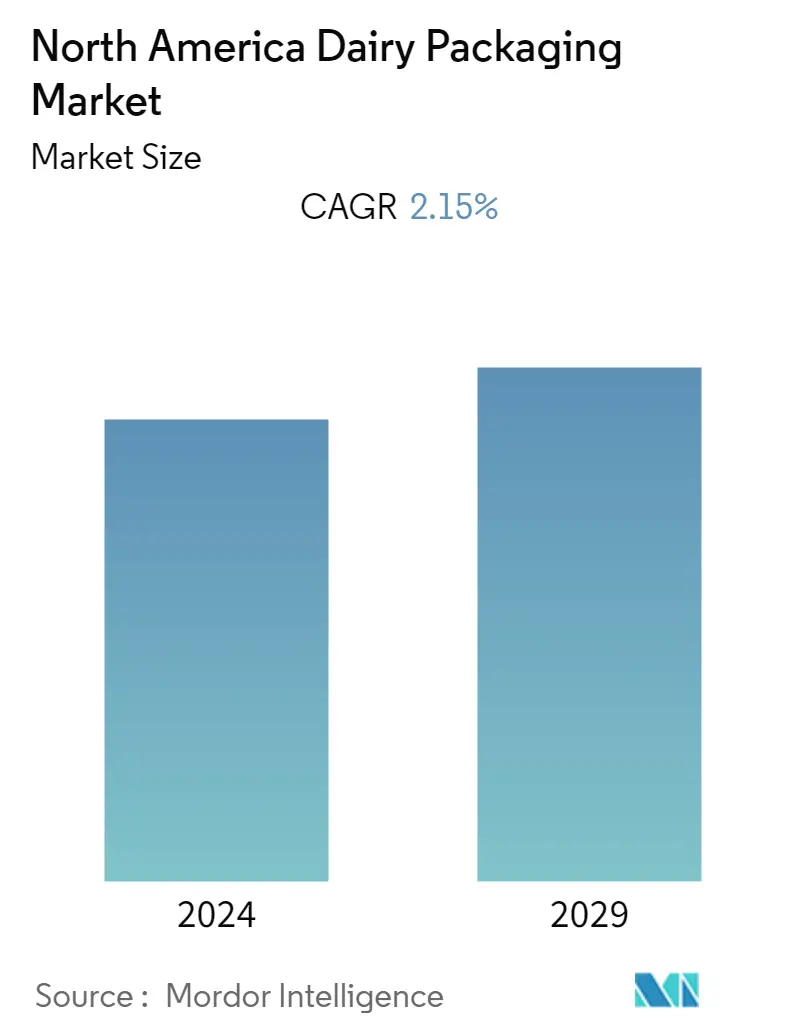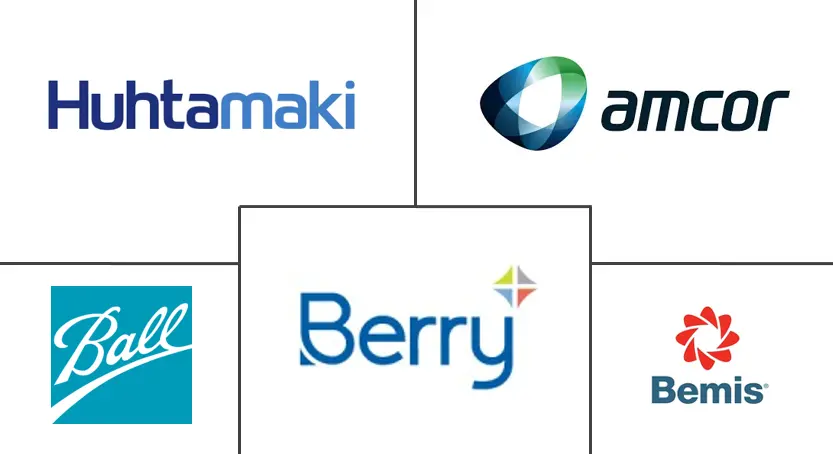Market Size of North America Dairy Packaging Industry

| Study Period | 2019 - 2029 |
| Base Year For Estimation | 2023 |
| Forecast Data Period | 2024 - 2029 |
| Historical Data Period | 2019 - 2022 |
| CAGR | 2.15 % |
| Market Concentration | Medium |
Major Players
*Disclaimer: Major Players sorted in no particular order |
North America Dairy Packaging Market Analysis
The Dairy Packaging Market in North America is expected to grow at a CAGR of 2.15% during the forecast period of 2020-2025. As millennial seek out products that are healthy and all-natural, dairy is often positioned as an attractive option. Numerous research studies have demonstrated that dairy, whether low or full-fat, offers health benefits, from combatting diabetes to boosting bone density, improving memory and complete mental health.
- The North American region accounts for the largest share in the global dairy packaging market, owing to the increased production and sale of dairy products, such as milk, cheese, and yogurt.
- Over the past few years, the consumption of dairy products in the United States has increased, especially cheese, parmesan, provolone, and mozzarella, which is likely to boost the utilization of dairy packaging in the country..
- The increasing per capita consumption of dairy products and production of cheese in the United States are poised to compel the manufacturers to innovate in the packaging, in order to cope with the demand and maintain price certainty, which is likely to foster the market growth over the forecast period.
- The disruption to supply chains due to coronavirus is causing tonnes of fresh produce to be wasted in the U.S. Despite food shortages and high demand for dairy produce, the Dairy Farmers of America has had to ask farmers to dump their milk. The disruption to supply chains means that farmers are unable to get their produce to market. The short shelf life and perishable nature of dairy products, means the effects of coronavirus have hit them harder, and faster, than other agricultural industries.
North America Dairy Packaging Industry Segmentation
The rapidly changing consumer preferences and economic scenario are significantly affecting the US dairy packaging market. Considerable expansion of dairy product portfolio, primarily into sports nutrition, along with an increasing number of casual users, is driving the import-export activities, as most of the users prefer to consume products of well-established brands.
| Material | |
| Plastic (PE, PP, PET, LDPE, and Other Plastics) | |
| Paper and Paperboard | |
| Glass | |
| Metal |
| Product | |
| Milk | |
| Cheese | |
| Frozen Products | |
| Cultured Products | |
| Other Product Types |
| Packaging | |
| Bottles | |
| Pouches | |
| Cartons and Boxes | |
| Bags and Wraps | |
| Other Packaging Types |
| Country | |
| United States | |
| Canada |
North America Dairy Packaging Market Size Summary
The North America dairy packaging market is experiencing growth driven by the increasing demand for dairy products such as milk, cheese, and yogurt. This region holds the largest share in the global market, supported by a rise in per capita consumption and production, particularly in the United States. The market is witnessing a shift towards innovative packaging solutions to meet the growing demand and ensure price stability. The disruption of supply chains due to the coronavirus pandemic has highlighted the challenges faced by the dairy industry, emphasizing the need for efficient packaging solutions to manage the perishable nature of dairy products. Cardboard and paperboard are gaining popularity as sustainable packaging materials, offering eco-friendly alternatives to traditional plastic solutions.
The market is characterized by a competitive landscape with major players like Huhtamaki Group, Berry Global Group Inc., Bemis Company Inc., and Amcor Limited leading the charge. These companies are focusing on innovative and sustainable packaging solutions to expand their market presence. The adoption of biodegradable and recyclable materials, such as paper and paperboard, is on the rise, particularly for liquid dairy products. Additionally, advancements in packaging technology, such as aseptic packaging, are enhancing the shelf life and quality of dairy products like yogurt. The clean eating movement is also influencing consumer preferences, with a growing demand for functional and healthier dairy options.
North America Dairy Packaging Market Size - Table of Contents
-
1. MARKET DYNAMICS
-
1.1 Market Overview
-
1.2 Assesment of Covid-19 on Dairy Packaging Market
-
1.3 Market Drivers
-
1.3.1 Increasing Consumer Preference toward Protein-based Products
-
1.3.2 Increasing Adoption of In-House Packaging Methods
-
1.3.3 Increasing Adoption of Packages Incorporating Small Portion Size
-
-
1.4 Market Restraints
-
1.4.1 Greenhouse Gas Emission due to Dairy Activities Leading to Legislative Issues
-
-
1.5 Value Chain Analysis
-
1.6 Porters Five Force Analysis
-
1.6.1 Threat of New Entrants
-
1.6.2 Bargaining Power of Buyers/Consumers
-
1.6.3 Bargaining Power of Suppliers
-
1.6.4 Threat of Substitute Products
-
1.6.5 Intensity of Competitive Rivalry
-
-
-
2. MARKET SEGMENTATION
-
2.1 Material
-
2.1.1 Plastic (PE, PP, PET, LDPE, and Other Plastics)
-
2.1.2 Paper and Paperboard
-
2.1.3 Glass
-
2.1.4 Metal
-
-
2.2 Product
-
2.2.1 Milk
-
2.2.2 Cheese
-
2.2.3 Frozen Products
-
2.2.4 Cultured Products
-
2.2.5 Other Product Types
-
-
2.3 Packaging
-
2.3.1 Bottles
-
2.3.2 Pouches
-
2.3.3 Cartons and Boxes
-
2.3.4 Bags and Wraps
-
2.3.5 Other Packaging Types
-
-
2.4 Country
-
2.4.1 United States
-
2.4.2 Canada
-
-
North America Dairy Packaging Market Size FAQs
What is the current North America Dairy Packaging Market size?
The North America Dairy Packaging Market is projected to register a CAGR of 2.15% during the forecast period (2024-2029)
Who are the key players in North America Dairy Packaging Market?
Huhtamaki Group, Berry Global Group Inc., Bemis Company Inc., Amcor Limited and Ball Corporation are the major companies operating in the North America Dairy Packaging Market.

